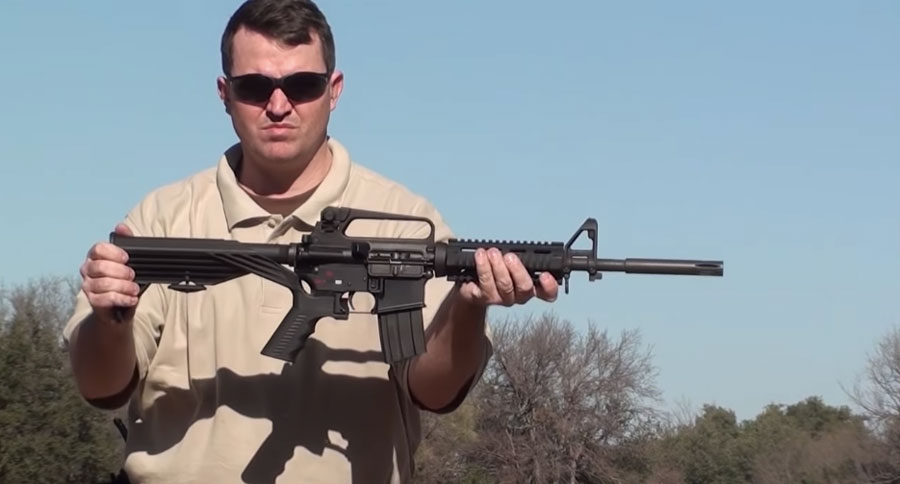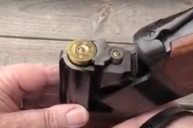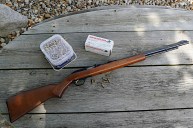Following the ATF's federal bump stock ban, many people still don't know what they actually are.
It's probably safe to say that bump stocks are devices most people in the United States had never heard of until the horrid trend of mass shootings. With that in mind, let's break down what exactly they are.
Before we get started talking about bump stocks, though, here's some useful background information to help put things in context.
As we discussed in a previous article, the National Firearms Act (NFA) of 1934 and the Firearms Owners Protection Act of 1986 placed very strict limits on the manufacture, transfer, and ownership of machine guns by civilians in the United States. Neither law amounted to an outright ban on machine guns, but they had the effect of significantly limiting the legal supply of machine guns that civilians could lawfully possess. For that reason, civilian owned machine guns are very rare and very expensive in the United States.
The NFA defines a "machine gun" as "any weapon which shoots, is designed to shoot, or can be readily restored to shoot, automatically more than one shot, without manual reloading, by a single function of the trigger."
Basically, any firearm that fires more than one shot each time the trigger is pulled is a machine gun, according to the NFA. By the same token, though, any firearm that only fires a single shot when the trigger is pulled (regardless of the actual rate of fire) is not a machine gun and is therefore not subject to those same stringent regulations.
As a result, semi-automatic firearms are much more common and much less expensive. With that in mind, shooters have developed several different techniques and devices to help achieve high rates of fire using semi-automatic weapons. One way of doing that is by using the "bump fire" method.
How do bump stocks work?
Put simply, bump firing is when the shooter harnesses the recoil of the firearm to assist in rapid-fire pulling of the trigger. When bump firing, the shooter exerts steady forward pressure on the stock with the support hand. The recoil produced by a firearm when it shoots pushes it backwards, but the shooter's shoulder and the forward pressure on the stock "bump" it back forward until the trigger contacts the trigger finger. At this point, the firearm shoots again and starts the process over, increasing the firing rate without doing anything technical to change the mechanics of the gun.
According to the Bureau of Alcohol, Tobacco, Firearms and Explosives, bump stocks offer a "cyclic firing rate to mimic nearly continuous automatic fire."
As you can see in the video below of a gun owner doing a bump fire demonstration, a shooter can achieve a pretty high rate of fire using this technique.
A really good three gun competitor can shoot two or three rounds a second with a semi-automatic rifle, which translates into a rate of fire of about 120-180 rounds per minute. The vast majority of people simply cannot squeeze the trigger much faster than that. However, a shooter can double that rate of fire when bump firing.
On the other hand, bump firing is not conducive to a high level of accuracy. Like you saw in the video, the guy was not cradling the rifle in his shoulder and did not have a firm grasp on the hand grip. Yeah, he shot a lot of rounds off very quickly, but it's doubtful he'd be able to hit anything out past 25 yards or so when bump firing.
In addition to the inherent inaccuracy of bump firing, it's also a somewhat difficult technique to pull off because it requires a fair amount of strength and coordination. As a way of getting around these problems, some shooters designed a device we now know as a bump stock several years ago.
A bump stock operates under the basic same principles the guy was using while bump firing in the video above. The major difference though is that instead of bouncing back and forth off the shooter's shoulder, a bump stock is designed to slide back and forth. This allows the shooter to exercise more control over the firearm.
As you can see in the promotional video below made by Slide Fire (a leading manufacturer of bump fire stocks), a bump stock is also relatively user-friendly.
Now, accuracy is a relative term and is inversely related to rate of fire (the faster you shoot, the less accurate your shots normally are). So, while a firearm equipped with a bump stock will probably be more accurate than an off the shelf firearm simply being bump fired without a bump stock, neither is a poster boy for accurate shooting.
Regardless of what some people may say, no, a bump stock does not convert a semi-automatic rifle into an automatic weapon or turn it into a machine gun. It just enables the shooter to pull the trigger really fast and shoot a lot of rounds off in a short amount of time.
Why are bump stocks illegal?
Well, many argue a bump stock makes a semi-automatic rifle fully automatic. But the bump stocks moved under the spotlight when they were used in the 2017 Las Vegas shooting, during which a gunman shot and killed 58 people.
In fact, even the National Rifle Association took a step back following the shooting.
"The NRA believes that devices designed to allow semi-automatic rifles to function like fully automatic rifles should be subject to additional regulations," the organization said in a statement.
The Trump administration signed an order for the federal ban of bump stocks February 20, and it went into effect as federal law March 26.
Like what you see here? You can read more great hunting articles by John McAdams on his hunting blog. Follow him on Facebook The Big Game Hunting Blog or Twitter @TheBigGameHunt.
NEXT: 6 OF THE BEST HANDGUNS FOR WOMEN LOOKING FOR A GOOD SELF-DEFENSE OPTION
WATCH
https://rumble.com/embed/u7gve.v3v88l/




